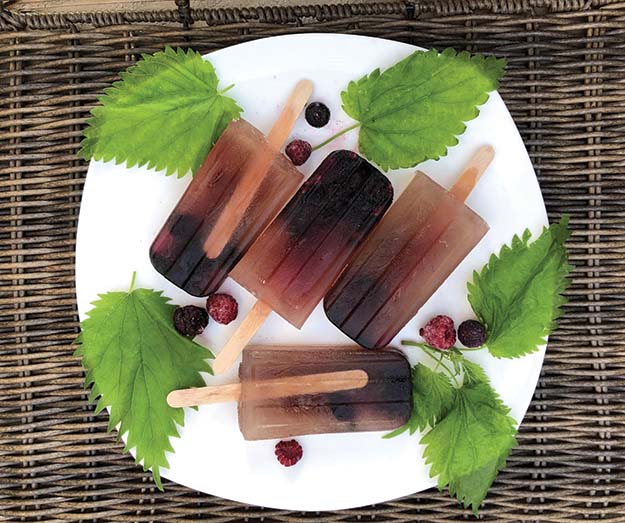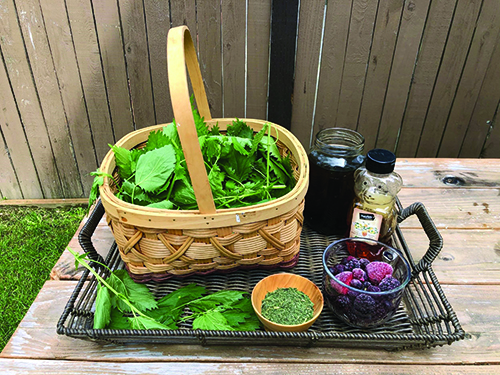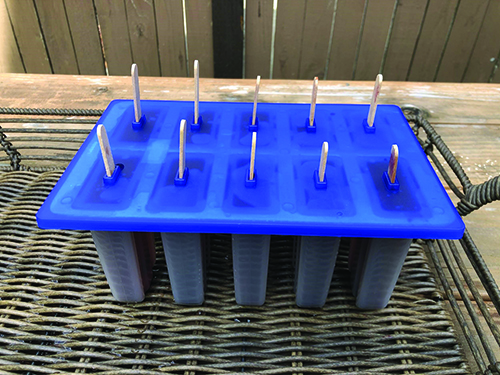
By SNAP-Ed Program Coordinator, AnneCherise Jensen
Looking for a healthy, fun and creative way to try Nettles this summer? Check out this Nettle Berry Popsicle recipe. It’s the perfect healthy summer snack for kids! As warmer weather approaches, this is a great way to turn any herbal tea into a crisp, refreshing treat for your friends and family. Since Nettles are in abundance this time of year, this is a great activity for not only in the kitchen, but outside as well. So grab your basket, gloves, and scissors and check your local woods for a nearby Nettle Patch! We have some wild crafted popsicles to make.
Foraging Nettles
Stinging Nettle, or sc̓ədᶻx̌, has been used as a traditional Coast Salish medicinal plant for thousands of years. This highly valued plant is often found in streambeds, forests and disturbed areas with rich wet soil, usually facing the sun. Stinging Nettles, can be found from the coast to the mountains, and are found in abundance on the lush Tulalip soils. Stinging Nettle, scientifically named Urtica diotica, is a perennial herb with opposite deep green leaves with serrated edges and tiny greenish flowers. The stems are square, and plants grow 3-7 feet tall annually.
Harvesting season runs March – June each spring. Once the Nettle plant begins to seed in the warmer summer months, the leaves can only be used for drying purposes. If consumed raw past this point, nettles can be toxic to the liver and kidneys. When harvesting Nettles, be sure to wear thick gloves as they will sting you! The stalk and underside of leaves are covered with stinging hairs that rise from a gland containing formic acid. Avoid harvesting in areas that are nearby pollutants, roads, pesticides and other chemicals. Cut off only the first 6 inches in the top of the plant. We do this to protect the plant and make sure it grows back the following year. Once you have your basket filled, the nettles can then be processed by blanching, drying or simply steaming them. Any of these methods will inhibit the formic acid glands (stingers) from stinging you. In this recipe, we will be using dehydrated nettles to make a sweet Nettle tea.
Dehydrating Nettles
When dehydrating Nettles, we want to use only the leaves of the plant. The stems are generally not used for food purposes, but can be used for making nets or are effective in compost. There are a few ways to dehydrate herbs; air-dry, dehydrate or an oven-dried method. All methods work effectively, but vary on resources and preference. I personally like to air-dry my herbs, but it can take up to a week. Either way, whatever way you choose, be sure to rinse your foraged herbs in a colander before drying. This also allows any bugs to escape that may be hiding in your basket. P.S. don’t forget to wear gloves – this is the prickliest process of all.
Dehydrator/Oven Method: Using heat is the quickest way to dry herbs. The dehydrator method requires a heat of 120-140 degrees F for about 12 hours in your average dehydrator. If you don’t have a dehydrator, you can also use an oven. Place herb leaves on a cookie sheet one inch deep or less. Put herbs in an open oven on low heat, less than 180 degrees F, for 2-4 hours. To see if the herbs are dry, check if leaves crumble easily. Oven-dried herbs will cook a little, removing some of the potency and flavor.
Air-Dry Method: Gather 5-10 branches together and tie with string or a rubber band. The smaller the bundle, the easier and faster they will dry. Put the bundle of herbs, stem-side up and hang them by the stem in a warm, well-ventilated room. You can do this by using string and clothespins, amongst other things. Your herbs may be dried and ready to store in as little as one week. This is personally my favorite method, as it preserves the potency and flavor of the herbs.
Nutritive Properties
Nettles are known to be one of the most nutrient dense plants on the Earth and are considered a super food in many cultures throughout the world. They contain a wide range of vitamins, minerals and antioxidants that help maintain the body’s function and mobility. Nettles also contain a high amount of amino acids that are highly valuable chemicals used in the pharmaceutical, cosmetic and food industries. Nettles contain extremely high amounts of Vitamin C, vitamin A, Vitamin D, iron, sodium, potassium, phosphorus, calcium (29 times more than spinach), magnesium, silica, trace minerals and protein (more than beans). No wonder they are called a superfood! If you aren’t already consuming nettles, you should be. (Krohn)
Medicinal Uses
Traditionally, Nettles have been used both internally and externally for a wide variety of uses. Nettles have been revered worldwide throughout the ages for food, fiber, and medicine. Many people say Nettles help to alleviate allergies as they contain antihistamine qualities that may be effective for acute allergic reactions. Other well-known uses of Nettles that are still being studied include; the strengthening of teeth, bones and hair, insulin resistance in Type 2 Diabetes, prostate health, blood detoxifier, increased hemoglobin for overall energy, reduced pain, menstrual cramp aid, and asthma. (Foret)
Other Uses
This plant is so versatile, it’s even been used to make natural dye with shades ranging from yellow to deep green. The nettle fibers/stem makes strong cordage and was used for making rope, fishing line and nets. Rosemary or horsetail with nettle are made into tea and used as a hair rinse to make the hair glossy and stimulate growth. “Sting yourself on purpose… really? Yes, it is true. People have stung themselves with nettle to ease pain. This is officially called urtication and its roots go deep into history on several continents.
Both in the Pacific Northwest and in Europe, people have stung themselves to cure arthritic joints and to stay awake and alert during battle or hunting. Traditional knowledge is now validated by scientific research. Compounds including histamine, acetylcholine and formic acid are injected into tissue causing an awakening of cellular responses, lymph flow, and nerve and capillary stimulation”. (Krohn)
As you can see, Nettles are a highly prized and sacred plant that can help keep you and your family healthy. Now that you’ve learned a little more about Nettles, it’s time to put your foraging skills to the test. Here is the summertime recipe you and your family will love.
If you are a Tulalip tribal member, and don’t have access to nettles but would like some, please contact AnneCherise Jensen and she will supply you with the dehydrated nettle tea.

Nettle Berry Popsicles
Ingredients
- 4 cups purified water
- ¼ cup Nettle Tea (Dried Nettle Leaves)
- ½ cup Fresh or Frozen Berries
- 2 -3 Tablespoons Honey or Cane Sugar
Directions
- Infuse dried nettle leaves in boiling water. Let steep on low heat for about an hour. The longer you allow the Nettle leaves to infuse, the more nutrients the tea will absorb.
- Add 2-3 Tbsp of honey or cane sugar to the lukewarm nettle tea. Mix well.
- Add the ½ cup of desired fresh or frozen berries to the nettle tea. Stir for a few minutes and allow the berries infuse in the water for about 5-10 minutes.
- Pour nettle tea mixture into a Popsicle mold. These can be found online or at Walmart, price ranging from $10- $25. If you don’t have a Popsicle mold, you can also use a small plastic cup and Popsicle sticks.
- Freeze for 2-3 hours, until firmly frozen.
- ENJOY!

**This material was funded by USDA’s Supplemental Nutrition Assistance Program – SNAP. This institution is an equal opportunity provider.
Sources:
http://wildfoodsandmedicines.com/nettle-restorative-food-purifying-medicine-guardian/ / Research provided Elise by Krohn
The Alchemy of Herbs, Rosalee De La Foret, pg 189 – 194